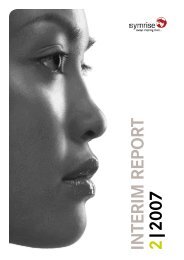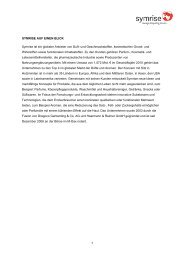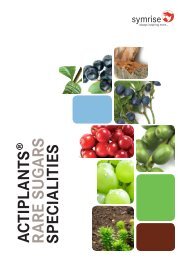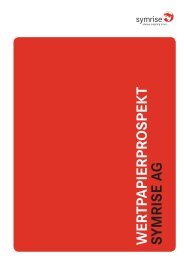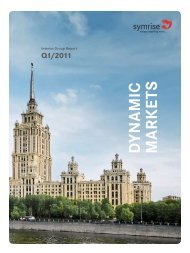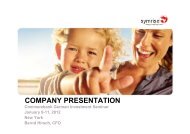THE NATURE OF OUR BUSINESS – STABLE GROWTH - Symrise
THE NATURE OF OUR BUSINESS – STABLE GROWTH - Symrise
THE NATURE OF OUR BUSINESS – STABLE GROWTH - Symrise
Create successful ePaper yourself
Turn your PDF publications into a flip-book with our unique Google optimized e-Paper software.
3. DETERMINATION <strong>OF</strong> FAIR VALUE<br />
Many of the Group’s accounting policies and note disclosure requirements<br />
require that a fair value is determined for financial and<br />
non-financial assets and liabilities. Fair value for measurement<br />
and/or disclosure purposes has been determined using the methods<br />
described below. Where applicable, further information regarding<br />
the assumptions used to determine fair value is contained<br />
in the notes specific to the particular asset or liability.<br />
Derivatives<br />
The fair value for an interest swap corresponds to the market price,<br />
inasmuch as an active market exists. If no market price is available,<br />
then fair value is estimated by discounting the difference between<br />
the contractually agreed price and the current price for the<br />
remaining term of the contract using a risk-free interest rate (based<br />
on government bonds).<br />
The fair value of a currency swap is based on listed market prices.<br />
These prices are validated by discounting estimated cash flows<br />
based on the individual contracts, using a market interest rate for<br />
a similar instrument at the date of the validation.<br />
Property, Plant and Equipment<br />
The fair value for items of property, plant and equipment recognized<br />
as a result of a business combination is based on market<br />
values. The market value for real estate is based on the estimated<br />
value at which the real estate could be sold on the day of measurement<br />
under the presumption that this would represent a business<br />
transaction between a willing buyer and a willing seller under<br />
the terms of which both parties operate knowledgeably, prudently<br />
and without compulsion and the transaction is preceded by adequate<br />
marketing activities. The market values of items of plant,<br />
equipment, fixtures and fittings are based on quoted prices for<br />
similar items.<br />
Intangible Assets<br />
The fair value of recipes recognized as a result of a business combination<br />
is based on discounted estimated royalty payments that<br />
were avoided as a result of the recipe becoming owned. The fair<br />
value of other intangible assets is based on the discounted cash<br />
flows that are expected to derive from the use and eventual sale<br />
of the asset.<br />
Investments and Other Financial Liabilities<br />
The fair value of investments that are traded on regulated financial<br />
markets is determined by reference to the stock exchange quoted<br />
market (bid) price. The fair value of investments for which no reg-<br />
ulated market exists is derived by reference to the current market<br />
price of comparable instruments or is calculated based on the<br />
cash flows expected to derive from the underlying asset. The fair<br />
value of financial liabilities determined for disclosure purposes is<br />
calculated on the present value of future principal and interest payment<br />
cash flows which are discounted using an interest rate valid<br />
at the balance sheet closing date.<br />
4. CAPITAL MANAGEMENT<br />
It is management’s policy to maintain a strong capital base in order<br />
to maintain investor, creditor and market confidence and to sustain<br />
the future development of the business. The Executive Board regularly<br />
monitors the ratio of net debt (including pension liabilities)<br />
to EBITDA. The Executive Board also regularly monitors the level of<br />
dividends paid to ordinary shareholders, for whom we aim to provide<br />
a level of dividend yield that justifies confidence in future business<br />
results.<br />
The Executive Board strives to maintain a balance between more<br />
favorable weighted average capital costs (WACC) by taking up additional<br />
borrowing and the advantages and security provided by a<br />
solid equity base. This also applies to suitable acquisition opportunities<br />
that are made possible for the Group by virtue of solid financing.<br />
The average interest expense on interest-bearing loans was 4.8%<br />
and the ratio of net debt to EBITDA was 3.2.<br />
There was no change in the Group’s approach to capital management<br />
during the reporting period. Neither the Company itself<br />
nor its subsidiaries are subject to externally imposed capital<br />
requirements.<br />
112 Annual Report 2008 <strong>Symrise</strong> AG




